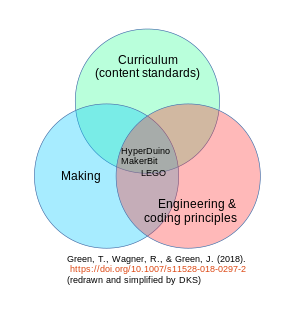Digital design and fabrication for ICT education: Difference between revisions
mNo edit summary |
m (→Introduction) |
||
| Line 6: | Line 6: | ||
- [[User:Daniel K. Schneider|Daniel K. Schneider]] ([[User talk:Daniel K. Schneider|talk]]) 16:27, 25 May 2018 (CEST) | - [[User:Daniel K. Schneider|Daniel K. Schneider]] ([[User talk:Daniel K. Schneider|talk]]) 16:27, 25 May 2018 (CEST) | ||
[[File:green-et-al-2018.svg|thumb| | [[File:green-et-al-2018.svg|thumb|300px|Green at al. 2018, A Look at Robots and Programmable Devices for the K-12 Classroom]] | ||
Digital design and fabrication for ICT education most often means assembling a robot from a variety of technologies and the programming it. Some technology, e.g. [http://hyperduino.com/hdrobotics.html HyperDuino], [http://makerbit.com Makerbit] or [https://www.lego.com/en-us/mindstorms LEGO Mindstorms]are more suitable to combine making and programming while respecting the curriculum, according to Green at al. who created a little taxonomgy that allows classifying use of tools according to educational outcomes. {{quotation|The ''curriculum domain'' focuses on outcomes that support learners using the tools to understand and demonstrate understanding of content (particularly related to content standardsThe ''making domain'' is strongly focused on outcomes that are craft-centric (i.e., making a product). The ''principles of engineering and coding domain'' focuses on outcomes associated with coding as the curriculum; learning to use the tools is the primary outcome of this domain. The overlapping of the circles combines the outcomes of the different domains.}} (Green et al. 2018) | Digital design and fabrication for ICT education most often means assembling a robot from a variety of technologies and the programming it. Some technology, e.g. [http://hyperduino.com/hdrobotics.html HyperDuino], [http://makerbit.com Makerbit] or [https://www.lego.com/en-us/mindstorms LEGO Mindstorms]are more suitable to combine making and programming while respecting the curriculum, according to Green at al. who created a little taxonomgy that allows classifying use of tools according to educational outcomes. {{quotation|The ''curriculum domain'' focuses on outcomes that support learners using the tools to understand and demonstrate understanding of content (particularly related to content standardsThe ''making domain'' is strongly focused on outcomes that are craft-centric (i.e., making a product). The ''principles of engineering and coding domain'' focuses on outcomes associated with coding as the curriculum; learning to use the tools is the primary outcome of this domain. The overlapping of the circles combines the outcomes of the different domains.}} (Green et al. 2018) | ||
== Bibliography == | == Bibliography == | ||
* Green, T., Wagner, R., & Green, J. (2018). A Look at Robots and Programmable Devices for the K-12 Classroom. TechTrends. https://doi.org/10.1007/s11528-018-0297-2 | * Green, T., Wagner, R., & Green, J. (2018). A Look at Robots and Programmable Devices for the K-12 Classroom. TechTrends. https://doi.org/10.1007/s11528-018-0297-2 | ||
Revision as of 10:42, 28 May 2018
Introduction
Digital design and fabrication in education is an emerging discipline, e.g. in the UK under the label "Design and technology". In this page we only focus on the potential of digital design and fabrication to teach and learn ICT skills.
Contents will include citations and summaries that then could be used for further exploration, research and teaching activities. - Daniel K. Schneider (talk) 16:27, 25 May 2018 (CEST)
Digital design and fabrication for ICT education most often means assembling a robot from a variety of technologies and the programming it. Some technology, e.g. HyperDuino, Makerbit or LEGO Mindstormsare more suitable to combine making and programming while respecting the curriculum, according to Green at al. who created a little taxonomgy that allows classifying use of tools according to educational outcomes. “The curriculum domain focuses on outcomes that support learners using the tools to understand and demonstrate understanding of content (particularly related to content standardsThe making domain is strongly focused on outcomes that are craft-centric (i.e., making a product). The principles of engineering and coding domain focuses on outcomes associated with coding as the curriculum; learning to use the tools is the primary outcome of this domain. The overlapping of the circles combines the outcomes of the different domains.” (Green et al. 2018)
Bibliography
- Green, T., Wagner, R., & Green, J. (2018). A Look at Robots and Programmable Devices for the K-12 Classroom. TechTrends. https://doi.org/10.1007/s11528-018-0297-2
